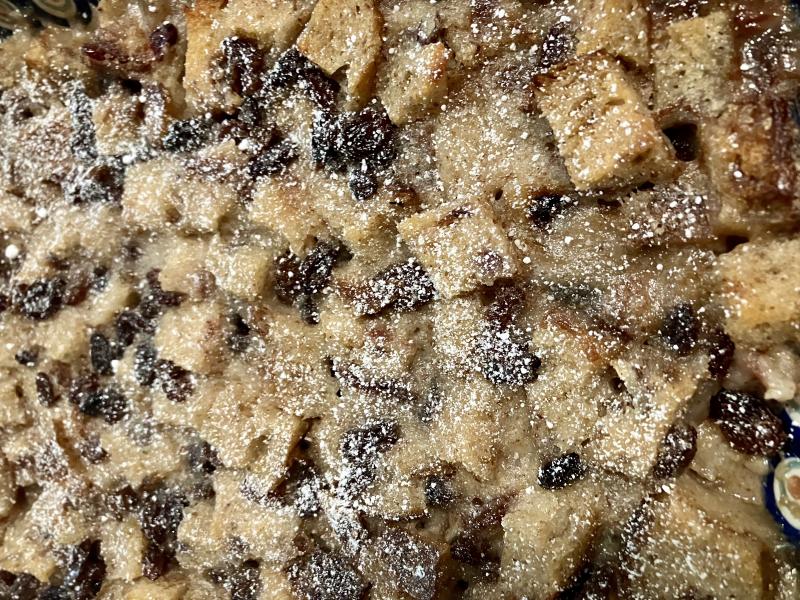Bread pudding recipes evolve to produce new favorites
Last week’s cooking demonstration at the Lodge featured two versions of bread pudding – one was a standard recipe, and the other used vegan ingredients. Although everyone swiftly devoured both samples, most people found they preferred the vegan version, which came as a bit of a surprise. What might have been the reasons?
To begin, we have to first define what we are calling bread pudding. It is pretty much as it sounds, a dish made of stale bread soaked in milk, then sweetened and baked. Over time, the addition of flavorings, butter and dried fruit such as raisins, currants or sultanas elevated the dish from something quite humble to a slightly more elegant dessert.
The origins of the dish can be traced back to medieval “sops,” when a hollowed-out bread loaf served as a container for a sweet dish. As you may imagine, the type of bread varied widely throughout the years, from the coarse-grained loaves of old to the modern practice of selecting brioche or slices of fruit-studded panettone. Spices such as nutmeg, cinnamon and allspice are often added, along with vanilla extract.
Since bread is a ubiquitous ingredient in most diets, it’s no surprise that variations on the dish can be found in a wide range of cultures. The Egyptian version includes phyllo (filo) pastry, cream, almonds and raisins. In India, you will find bread fried in ghee, dipped in a syrup flavored with saffron and rosewater, then covered with a creamy sauce and garnished with almonds.
The two recipes below show the difference between conventional western-style bread pudding (which has become a signature dish at many New Orleans restaurants) and the vegan-based approach. In both cases, you must begin with bread, either stale French bread, which works for both recipes, or a specifically vegan bread that contains no dairy, eggs or honey. For the dish in the photo, I used a homemade craisin nut loaf.
The next difference is the liquid. For the standard version, a combination of milk, melted butter and eggs provides the moisture. This is supplemented by the addition of drained, canned fruit. In the vegan version, we use coconut milk, vegan butter (made from plant-based oils, nuts or seeds), and applesauce to replace the egg. In both cases, you’ll want to add cinnamon, vanilla extract and raisins for flavor and texture interest.
Whichever version you choose to make, there is one crucial step in bread pudding that requires some physical strength. Before baking the dish, you need to cover the pan with aluminum foil and press down hard or place another pan on top and fill it with bricks or books to create a heavy weight. You want to make sure that every piece of bread is completely moistened, or you will have an unpleasantly crunchy top crust.
Finally, the baking time is critical. The conventional version is a custard of eggs and milk that needs to be cooked through. There’s nothing quite as unpleasant as finding strands of raw egg. However, you don’t want to overbake the dish, or the soft creaminess will be cooked away. The best way to test for doneness is to insert a knife in the center, which should come out clean.
Now, back to the original question about why the vegan version was more popular. I believe it had to do with the coconut milk. Since the regular recipe was fairly basic (no canned fruit, just some raisins), the texture and taste were somewhat bland. The coconut milk in the vegan version added a lovely flavor that won the day. Maybe we should build a recipe that combines the best aspects of both. In the meantime, here are two starting points.
Allie’s Vegan Bread Pudding
Preheat oven to 350 F. Coat the inside of a 9-by-9-inch pan with nonstick cooking spray. Arrange the bread in a single layer in the pan. Drizzle bread evenly with butter. Scatter raisins across the bread. In a mixing bowl, whisk together coconut milk, applesauce, sugar, vanilla and salt. Pour liquid evenly over pan, making sure to coat all the bread. Cover with foil and press down to ensure moisture is well distributed. Remove foil and bake for 40 minutes. Cool slightly, then sift confectioners’ sugar over the top. Serve warm. Yield: 6 servings.
New Orleans Bread Pudding*



















































